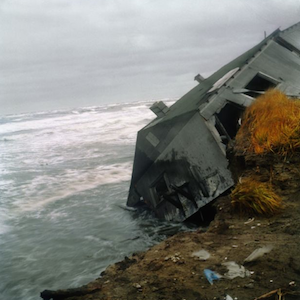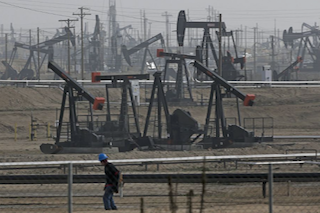Canada’s Frozen North Feels Financial Burn Of Global Warming

Source: Reuters YELLOWKNIFE, Northwest Territories, Canada, Oct 16 (Thomson Reuters Foundation) – C limate change is taking a heavy economic toll on Canada's far north, with buildings collapsing as melting permafrost destroys foundations, rivers running low and wildfires all a drain on the region's limited finances, senior government officials said. A sprawling area spanning the Arctic Circle with a population of less than 50,000, Canada's Northwest Territories has spent more than $140 million in the last two years responding to problems linked to global warming, the territory's finance minister said. "Our budgets are getting squeezed dramatically from climate change," Finance and Environment Minister J. Michael Miltenberger told the Thomson Reuters Foundation. "The roads are constantly moving as the permafrost is melting… massive shore erosion is putting buildings at risk. We have spent hundreds of millions of dollars in the past few years and the tie to climate change is more and more evident." In this windswept territory, which already relies on central government subsidies, responding to global warming is crucial for its financial survival. A major U.N. conference in Paris in December will aim to create a new global deal to curb climate change to take effect from 2020. Scientists want to keep international temperature rises below 2 degrees compared with pre-industrial levels, while providing poor countries with money for adaptation. But in parts of the Northwest Territories, average temperatures have already risen more than three degrees Celsius from pre-industrial levels, government officials said. Rapidly thawing permafrost is causing countless roadways to become all but impassible. "In Paris, we are hoping for whatever it takes to turn this (climate change) around," politician Bob Bromley told the Thomson Reuters Foundation in the territorial capital, Yellowknife. "It's going to require all hands on deck, and willing hands." Diesel Dependence The delicate ecosystem of the wide-skied territory, home to the indigenous Dene people, and where wolves, caribou and bison roam, has been plunged into a environmental vicious cycle. Climate change has been linked to decreased water levels in the territory's major rivers, partly due to greater evaporation, causing a sharp contraction in hydro electric power generation. As a result, the government has had to import more diesel, borrowing about $30 million this year alone to make up for the electricity shortfall, hurting its budget and increasing climate-warming emissions in a catastrophic feedback loop. "It's not sustainable," said Miltenberger, the finance and environment minister. He called on Canada's national government to provide more financial help for climate change mitigation, particularly in renewable power, to reduce the costs of importing diesel. With a small population, and high operating costs due to its size and climate, the territory's main employers are diamond mining and the public sector. The region's indigenous people rely on the hunting of caribou as a key food source, but herds are declining, with climate change likely a significant driver. Northwest Territories receives financial transfer payments of about $1.3 billion, or about $29,000 per resident, from Canada's national government to run public services. Craig Scott, executive director of Ecology North, a Yellowknife-based environmental group, believes the government should have invested earlier in renewable energy. Fuel trucks hauling diesel along gravel roads to small rural communities are a common site across the territory. Generators have been working around the clock following the decline in hydro power, Scott said, and new holding tanks had to be imported to store the diesel. "Renewable energies (including) micro hydro, solar and biomass have high capital costs in the short-term," Scott told the Thomson Reuters Foundation. "But they are sustainable versus the long-term pain of diesel." Source: Reuters
State Shuts 33 Wells Injecting Oil Wastewater Into Aquifers

Source: SFGATE California regulators on Thursday closed 33 oil company wells that had injected wastewater into potentially drinkable aquifers protected by federal law. The new closures bring to 56 the number of oil-field wastewater injection wells shut down by the state after officials realized they were pumping oil-tainted water into aquifers that potentially could be used for drinking or irrigation. All but two of the latest closures are in Kern County, in California’s drought-stricken Central Valley. One lies in Ventura County, another in northern Los Angeles County. Officials with California’s Division of Oil, Gas and Geothermal Resources spent Friday verifying that they had, in fact, closed. Of the 33, only 21 had been actively injecting wastewater before Thursday. “This is part of our ongoing effort to ensure that California’s groundwater resources are protected as oil and gas production take place,” said Steven Bohlen, the division’s supervisor. California’s oil fields contain large amounts of salty water that comes to the surface mixed with the oil. It must be separated from the petroleum and disposed of, often by injecting it back underground. Much of the water is pumped back into the same geologic formation it came from. But enough left-over water remains that companies must find other places to put it. Fears of contamination The division, part of California’s Department of Conservation, for years issued oil companies permits to inject their left-over water into aquifers that were supposed to be off-limits, protected by the federal Safe Drinking Water Act. The problem, detailed in a Chronicle investigation earlier this year, raised fears of water contamination in a state struggling through a historic, four-year drought. So far, however, no drinking water supplies have been found to be tainted by the injections. Still, some environmentalists expressed outrage that so few wells had been closed. The division has identified 178 wells that were injecting into legally protected aquifers with relatively high water quality, defined as those with a maximum of 3,000 parts per million of total dissolved solids. More than 2,000 other wells inject into aquifers that would be harder to use for drinking water, either because they are too salty or because they also contain oil. “This is too little, too late to protect our water,” said Kassie Siegel, director of the Climate Law Institute at the Center for Biological Diversity. “With each passing day the oil industry is polluting more and more of our precious water.” The division reported Friday, however, that not all 178 wells required closure. Some had already been shut down by their operators, while others had been converted into wells for extracting oil — not dumping wastewater. Source: SFGATE
International “Eluxe Magazine” Makes Their Voice Heard On The Geoengineering Threat

We can now add yet another source to the growing list of important publications that have already spoken out about the critical climate engineering issue, "Eluxe Magazine". Below is an excerpt from their impressive "about" section. Eluxe Magazine is the world’s first ever publication fully dedicated to sustainable luxury. We’re a quarterly published paper magazine and a digital publication based in London and Paris, dedicated to showcasing luxury brands that demonstrate a strong commitment to good ethics and environmental sustainability. We determine the sustainability of a brand on several factors, including whether it: Uses organic, biodegradable, recycled or renewable materials Traces the environmental accountability of the product throughout the supply chain Follows a strict Corporate Sustainability Policy, with transparent annual reports. Uses recyclable, recycled or no packaging Creates a product whose consumption can greatly reduce the owner’s environmental impact Other publications that have already done their part to sound the alarm on atmospheric spraying atrocities are SOCO magazine and National Health Freedom magazine. The wave of awareness and outrage is building very rapidly as people around the globe wake up to what has been done to them without their knowledge or consent. Momentum is growing exponentially in the most critical battle of all, the fight to take back our skies from the grip of the collective insanity that has all but decimated our planet. We must all keep marching forward in this battle with all the strength and speed we can manage, every day counts. My most sincere thanks to Eluxe Magazine for solidly joining us in all important effort to expose global climate engineering. Dane Wigington geoengineeringwatch.org
